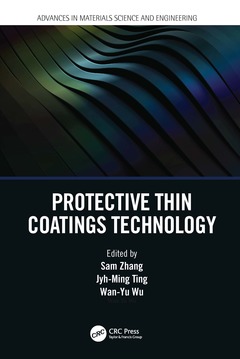Description
Protective Thin Coatings Technology
Advances in Materials Science and Engineering Series
Language: English
Subjects for Protective Thin Coatings Technology:
Keywords
Magnetron Sputtering; High Power Impulse Magnetron Sputtering; PEO Coating; HEA Coating; Nanocomposite Coatings; MAO Coating; Multilayer Coating; Corrosion Current Density; Solid Lubrication; SAED Pattern; Magnesium Alloy Substrate; BCC Phase; Anti-wear Property; FCC Phase; CVD Graphene; HGF Cell; EDS Analysis; Magnesium Alloy; Substrate Bias Voltage; Relative Indentation Depth; Monolayer Graphene; GIXRD Pattern; AZ31 Magnesium Alloy; High Entropy Effect; Laser Cladding
· 17.8x25.4 cm · Hardback
Description
/li>Contents
/li>Biography
/li>
Hard or protective coatings are widely used in conventional and modern industries and will continue to play a key role in future manufacturing, especially in the micro and nano areas. Protective Thin Coatings Technology highlights the developments and advances in the preparation, characterization, and applications of protective micro-/nanoscaled films and coatings.
This book
- Covers technologies for sputtering of flexible hard nanocoatings, deposition of solid lubricating films, and multilayer transition metal nitrides
- Describes integrated nanomechanical characterization of hard coatings, corrosion and tribo-corrosion of hard coatings, and high entropy alloy films and coatings
- Investigates thin films and coatings for high-temperature applications, nanocomposite coatings on magnesium alloys, and the correlation between coating properties and industrial applications
- Features various aspects of hard coatings, covering advanced sputtering technologies, structural characterizations, and simulations, as well as applications
This first volume in the two-volume set, Protective Thin Coatings and Functional Thin Films Technology, will benefit industry professionals and researchers working in areas related to semiconductors, optoelectronics, plasma technology, solid-state energy storages, and 5G, as well as advanced students studying electrical, mechanical, chemical, and material engineering.
Chapter 1 Advanced Sputtering Technologies of Flexible Hard Nanocoatings
Jindřich Musil and Šimon Kos
Chapter 2 Solid Lubricating Films
JieJin, Dandan Chen, and Zhe Jiang
Chapter 3 Multilayer Transition Metal Nitride Protective Coatings
Fan-Bean Wu, Yung-I Chen, Jyh-Wei Lee, and Jenq-Gong Duh
Chapter 4 Integrated Nanomechanical Characterisation of Hard Coatings
Ben D. Beake, Vladimir M. Vishnyakov, and Tomasz W. Liskiewicz
Chapter 5 Corrosion and Tribo-Corrosion of Hard Coating Prepared by Advanced Magnetron Sputtering
Deen Sun
Chapter 6 High-Entropy Alloy-Based Coatings
Yujie Chen, Paul Munroe, Zonghan Xie, and Sam Zhang
Chapter 7 High-Temperature Thin Films and Coatings
Xingang Luan, Xingmin Liu, and Yuchang Qing
Chapter 8 Roads Toward Surface Protection of Magnesium Alloys
Wenling Xie, Bin Liao, and Sam Zhang
Chapter 9 Correlation between Coating Properties and Industrial Applications
Yin-Yu Chang, Heng-Li Huang, Jui-Ting Hsu, and Ming-Tzu Tsai
Chapter 10 The Wear Behavior and Mechanism of Graphene
Yuehua Huang
These books may interest you

Functional Thin Films Technology 160.25 €



